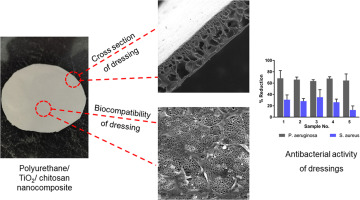Journal of the Mechanical Behavior of Biomedical Materials ( IF 3.9 ) Pub Date : 2018-09-04 , DOI: 10.1016/j.jmbbm.2018.09.001 Arman Jafari , Shadi Hassanajili , Mohammad Bagher Karimi , Amir Emami , Farnaz Ghaffari , Negar Azarpira

|
This study focuses on the evaluation and modification of polyurethane (PU) membranes containing organic and inorganic nanoparticles for potential use as a wound dressing. For the purpose of PU nanocomposite preparation, chitosan (CS) was converted into nanoparticles by the ionic-gelation method to improve its blending capability with the PU matrix. These CS nanoparticles (nano-CS) were obtained as a hydrophilic organic filler with different contents and were utilized along with inorganic titanium dioxide (TiO2) nanoparticles in the nanocomposite membrane preparation. The membranes were prepared using phase inversion technique and their microstructure was controlled by manipulating the solvent non-solvent exchange rate. Obtained results demonstrate that addition of polymer solvent to nonsolvent induced a microstructure alteration from finger-like to sponge-like, which is more suitable for fluid uptake and consequently more useful for wound dressing applications. Similar results were obtained by introduction of nanoparticles to membranes. Due to the polar nature of nanoparticles and their effects on PU structure, prepared membranes showed 71.5% improve in swelling when compared to neat PU. Moreover, the reinforcement effect of nanoparticles caused an 18.94% increase in ultimate tensile strength in comparison with bare PU film, while elongation at break was not affected considerably. In addition, prepared PU nanocomposite films showed suitable antibacterial activity of 69% against Staphylococcus aureus and did not show any toxicity to human fibroblast cells. Based on these results, simultaneous use of TiO2 and chitosan nanoparticles can improve both physical and antibacterial properties of PU as an ideal wound dressing.
中文翻译:

有机/无机纳米粒子对聚氨酯纳米复合材料潜在伤口敷料应用性能的影响
这项研究的重点是评估和改性包含有机和无机纳米粒子的聚氨酯(PU)膜,这些膜有可能用作伤口敷料。为了制备PU纳米复合材料,壳聚糖(CS)通过离子凝胶法转化为纳米颗粒,以提高其与PU基质的共混能力。获得这些CS纳米颗粒(nano-CS)作为不同含量的亲水性有机填料,并将其与无机二氧化钛(TiO 2)纳米复合膜制备中的纳米颗粒。使用相转化技术制备膜,并通过控制溶剂非溶剂交换速率来控制其微结构。获得的结果表明,将聚合物溶剂添加到非溶剂中会导致微观结构从手指状变为海绵状,这更适合液体吸收,因此更适合伤口敷料应用。通过将纳米颗粒引入膜获得了相似的结果。由于纳米粒子的极性及其对聚氨酯结构的影响,与纯聚氨酯相比,制得的膜的溶胀度提高了71.5%。此外,与裸露的PU膜相比,纳米颗粒的增强作用使极限拉伸强度提高了18.94%,断裂伸长率没有受到很大的影响。此外,制备的PU纳米复合膜对69%的细菌具有合适的抗菌活性。金黄色葡萄球菌对人成纤维细胞没有任何毒性。基于这些结果,同时使用TiO 2和壳聚糖纳米颗粒可以同时改善PU的物理和抗菌性能,使其成为理想的伤口敷料。



























 京公网安备 11010802027423号
京公网安备 11010802027423号